 |


















|
 |
 |
|
author:
|
Iris R. Weiss, Kathleen A. Rapp, Diana L. Montgomery
|
|
description:
|
"In its second year of implementation, the Local Systemic Change Initiative supported 26 projects involving a total of 121 districts throughout the United States. LSC projects are characterized by their focus on adoption and use of exemplary science and mathematics instructional materials. These projects are also distinguished from teacher enhancement projects of the past by their systemic focus, including targeting all teachers in participating schools rather than volunteer teachers, and reviewing district and school policies and practices to determine the extent of alignment with the reform vision. The LSC Initiative is proving to be an effective mechanism for providing high quality professional development to large numbers of teachers. Moreover, by operating in a systemic context, the LSC projects have the potential for greater and more sustained impact than has typically been the case in teacher enhancement projects involving individual teachers from a large number of schools and districts.
Data on the quality and impact of the LSC projects come from teacher and principal questionnaires, teacher interviews, and observation of both professional development activities and science and mathematics classrooms."
|
|
published in:
|
Horizon Research, Inc.
|
|
published:
|
10/01/1997
|
|
posted to site:
|
02/10/1998
|
October 1997
Horizon Research, Inc.
111 Cloister Court - Suite 220
Chapel Hill, NC 27514-2296
Summary
In its second year of implementation, the Local Systemic Change Initiative supported 26 projects
involving a total of 121 districts throughout the United States. LSC projects are characterized by their
focus on adoption and use of exemplary science and mathematics instructional materials. These
projects are also distinguished from teacher enhancement projects of the past by their systemic focus,
including targeting all teachers in participating schools rather than volunteer teachers, and reviewing
district and school policies and practices to determine the extent of alignment with the reform vision.
The LSC Initiative is proving to be an effective mechanism for providing high quality professional
development to large numbers of teachers. Moreover, by operating in a systemic context, the LSC
projects have the potential for greater and more sustained impact than has typically been the case in
teacher enhancement projects involving individual teachers from a large number of schools and
districts.
Data on the quality and impact of the LSC projects come from teacher and principal questionnaires,
teacher interviews, and observation of both professional development activities and science and
mathematics classrooms.
Quality of Professional Development
Project evaluators observed a number of professional development sessions in each project using a
standardized protocol developed by Horizon Research, Inc. These sessions generally received high
marks for the quality of their design and implementation, for the appropriateness of the disciplinary and
pedagogical content, and their inclusive, collegial culture. Overall, the LSC programs appear to be
well-aligned with national science and mathematics standards, and in particular those for
professional development; projects generally attend to important science and mathematics content
and pedagogy in a spirit of inquiry, reflection, and continuous improvement.
Evaluators noted a number of ways in which the LSC professional development reflects current
standards for best practice in professional development. Among these are the relevancy of professional
development activities to teachers' work in classrooms, the way in which professional development
typically modeled effective pedagogical strategies; the opportunities for teachers to reflect individually
and with their colleagues; and the attention to follow-up support as teachers worked on implementing
standards-based curriculum materials in their classrooms.
At the same time, evaluators in some projects have noted a need for greater attention to the balance
between content and pedagogy when helping teachers learn to implement exemplary instructional
materials; "going through the activities" is valuable, but teachers also need opportunities to explore the
conceptual underpinnings of these activities in more depth. Also, evaluators note that projects using
inexperienced professional development providers need to pay greater attention to ensuring consistently
high quality service delivery; this issue was particularly important in projects where university
scientists and/or lead teachers were responsible for conducting professional development sessions.
Impact on Teachers and Teaching
Teachers who had participated in LSC professional development were generally quite positive about
their experiences, indicating that they had become more confident in teaching science as a result.
Moreover, teachers who have participated extensively in science and mathematics professional
development report higher levels of preparedness and more frequent use of standards-based
instructional strategies than do teachers with less professional development involvement.
It is important to note that most teachers in LSC districts reported very positive attitudes towards
science and mathematics reform, indicating that they recognize the value of many standards-aligned
instructional strategies. However, there is a large disparity between the perceived importance and the
preparedness teachers feel for implementing reform strategies in their classrooms. Similarly, sizable
proportions of teachers report feeling less than well prepared to teach a number of science and
mathematics topics they are expected to teach.
There was a marked consistency in the picture of classroom instruction that emerged from teacher
questionnaires and classroom observations. Teacher presentations are quite common in the LSC
districts, with most observed lessons including a formal presentation by the teacher. While most
observed lessons also included some kind of hands-on/investigative activity, these typically involved
students following detailed instructions to answer predetermined questions, rather than allowing the
students to pose questions and design their own investigations to address these questions.
Science lessons taught by teachers who had participated in LSC professional development were more
likely than baseline science or mathematics lessons to be rated highly on the extent to which the
discipline was portrayed as a process of inquiry; students were encouraged to generate ideas,
conjectures, and propositions; and the degree of closure was appropriate for the purposes of the
lesson.
Providing a Supportive Context for Teachers
In keeping with NSF's focus on system-wide reform, the core evaluation questionnaires and interviews
asked teachers about the support they receive from parents, principals, and other teachers in their
schools. Teachers in the LSC districts generally feel supported by other teachers in their schools to try
out innovative ideas in science and mathematics teaching, but they rarely have time during the regular
school week to work with one another. In fact, lack of time to work with other teachers, inadequate
funds for purchasing equipment and supplies, lack of access to computers, and the need for more
planning time headed the list of problems for science and mathematics instruction reported by both
teachers and principals.
Evaluators were also asked to describe the extent to which district policies and resources were aligned
in support of the LSC reforms and the likelihood that the reforms would be sustained after the NSF
funding period had ended. Most projects were rated at Level 3 (out of a possible 5) in terms of
district support, indicating that district policies were in transition toward a more supportive context.
Many spoke of commitments the districts had made to the LSC reforms, including purchasing kit-based
instructional programs and establishing centers for maintaining and refurbishing the kits.
Finally, while many LSC projects have begun the process of developing lead teachers and otherwise
increasing internal capacity to provide high quality professional development, many of the LSC districts
do not yet have the mechanisms or resources to sustain these systems.
Acknowledgments
The core evaluation of the Local Systemic Change Initiative requires the energy, efforts, and
insights of a very large number of people.
Conrad Katzenmeyer in the National Science Foundation's (NSF) Division of Research,
Evaluation, and Communication; Joyce Evans, Susan Snyder, and Diane Spresser in NSF's
Division of Elementary, Secondary, and Informal Education (ESIE); and Joy Frechtling of
Westat, Inc. were instrumental in the design and implementation of the core evaluation system.
Numerous other NSF/ESIE program officers provided valuable assistance throughout the
process, as well.
Within HRI, in addition to the authors of this report, Joan Pasley, Ruth Pershing, Ben Kurgat,
Eugene Soar, Scott Hanrath, Jarrod Jenzano, Alison Schaff, Carol McDonald, Susan Hudson,
Claudia Templeton, and John Supovitz were responsible for various tasks essential to the
production of this report, from instrument design, to data processing and analysis, to report
production.
Most notably, this report would not have been possible without the efforts of the LSC project
lead evaluators, who persevered as we attempted to fine-tune the core evaluation system. And
special thanks are due to the thousands of teachers throughout the 121 participating districts who
took time from their busy schedules to provide information about their science and mathematics
teaching.
Table of Contents
| Summary |
ii |
| Acknowledgments |
v |
| Introduction |
1 |
| Description of LSC Professional Development |
2 |
| Teacher Preparedness in Science and Mathematics Education |
6 |
| Classroom Practice |
8 |
| Supportive Context for Reform |
16 |
| Sustainability of the LSC Reforms |
19 |
Introduction
In 1995, the National Science Foundation (NSF) began its Local Systemic Change through
Teacher Enhancement Program (LSC). The goal of the program is to improve the teaching of
science, mathematics, and technology by focusing on the professional development of teachers
within whole schools or school districts. Each targeted teacher is to participate in a minimum of
100 hours of professional development with an emphasis on preparing them to implement
exemplary science and mathematics instructional materials in their classrooms.
LSC projects are expected to align policy and practice within the targeted district(s) and to
include:
- A shared comprehensive vision of science, mathematics, and technology education;
- Active partnerships and commitments among stakeholders;
- A detailed self-study that provides a realistic assessment of the current system's strengths and needs;
- Strategic planning that incorporates mechanisms for engaging each teacher in intensive professional development activities over the course of the project; and
- A set of clearly defined, measurable outcomes for teaching, and an evaluation plan that provides on-going feedback for the project.
The LSC projects are distinguished from teacher enhancement projects of the past by their
systemic focus, including professional development for all teachers of science/mathematics at the
targeted grade levels, the implementation of exemplary instructional materials, and the alignment
of district policies and practices with the reform vision.
NSF contracted with Horizon Research, Inc. (HRI) to design and implement an evaluation for
collecting data that could be aggregated across projects. The core evaluation system designed by
HRI in conjunction with NSF and the project PIs and evaluators includes observations of
professional development activities and science and mathematics classrooms; teacher and principal
questionnaires; and teacher interviews. Project evaluators use these data, as well as any
additional, project-specific data they may have collected, to address the following core evaluation
questions:
- What is the overall quality of the LSC professional development activities?
- What is the extent of school and teacher involvement in LSC activities?
- What is the impact of the LSC professional development on teacher preparedness, attitudes, and beliefs about science and mathematics teaching and learning?
- What is the impact of the LSC professional development on classroom practices in science and mathematics?
- To what extent are the district and school contexts becoming more supportive of the LSC vision for exemplary science and mathematics education?
- What is the extent of institutionalization of high quality professional development systems in the LSC districts?
Project data sheets completed by the PIs provide some basic information about the 26 projects included in Cohorts 1 and 2.1
- Roughly half of the Cohort 1 and Cohort 2 projects are single-district projects; at the other end of the scale, 4 projects involve more than 10 districts, including 1 with 21 districts.
- The 8 Cohort 1 projects and 18 Cohort 2 projects plan to involve a total of 28,239 teachers in 1,312 schools in 121 districts across the United States.
- By the completion of these projects, an estimated 706,000 students will receive instruction from LSC-treated teachers each year.
- 20 projects target K-8 science; 2 projects target K-8 mathematics; and 4 projects target both K-8 science and mathematics.
This report presents highlights from the 1995-96 project year, including results from the 8 Cohort
1 projects that were in their second year of funding and the 18 Cohort 2 projects that were funded
in 1996.2
Description of LSC Professional Development
Core evaluation data to assess the quality of LSC professional development activities come from
observations of the professional development activities, and to a lesser extent, from teacher
questionnaires. Cohort 1 projects augmented these data with teacher interviews. Based on these
data, evaluators were asked to rate the quality of the project's professional development in eight
component areas and to provide an overall rating of the project's professional development
system.
|
Evaluators observed a total of 180
professional development activities,
an average of 7 per project. Using
a standard protocol developed by
HRI, they described the sessions
they observed; they also assessed
the appropriateness of the design of
each session for accomplishing the
stated purposes and the quality of
its implementation.
As can be seen in Figure 1, nearly
half of the observed science
sessions included physical science
content, 37 percent focused on life
science, and 33 percent had an
earth-science content focus.
|
Major Disciplinary Content Areas of Observed Science Professional Development Sessions
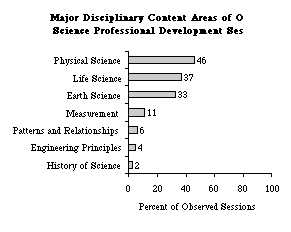
Figure 1
|
|
Major Disciplinary Content Areas of Observed Mathematics Professional Development Sessions
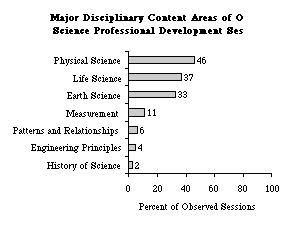
Figure 2
|
Among projects targeting
mathematics, the content areas of
focus were most often computation
and estimation, numeration and
number theory, patterns and
relationships, and mathematical
problem solving. (See Figure 2.)
While a few of the science sessions
included emphasis on one or more
mathematics topics (especially
measurement), none of the
mathematics sessions included
science content as a major focus.
|
Figure 3 shows evaluators' overall "capsule ratings" of the observed sessions. Very few LSC
sessions were rated as ineffective professional development (Level 1), and fewer than 10 percent
were rated at Level 2, having quite limited likelihood of helping participants implement exemplary
science/mathematics instruction or be leaders in reform. More than 60 percent of the observed
professional development sessions received ratings of 4 or 5, with Cohort 1 sessions somewhat
more likely than Cohort 2 sessions to be considered "exemplary professional development."
Professional Development Capsule Ratings of Observed Sessions
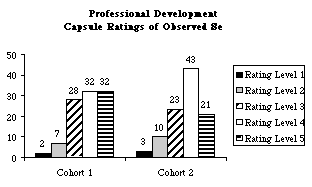
Figure 3
The sample vignettes that follow illustrate two sessions with similar purposes, but judged to be
quite different in quality.
| Professional Development Session #1:
Third and fourth grade teachers were engaged in professional development around a kit-based
unit on water. One session focused on a lesson involving construction of a water thermometer.
There were multiple goals for participants: (a) to experience learning by inquiry, (b) to try out
the activity, and (c) to learn about instructional strategies. The facilitator began by questioning
the participants to learn what they already knew about thermometers, modeling the kinds of
questions and problems teachers might pose with their own students.
Pairs of participants constructed thermometers, and were engaged in making predictions,
investigating how those predictions could be tested, and actually carrying out mini-investigations.
The implementation was a real strength of the session. The facilitator knew just when to ask
thought-provoking questions to keep participants thinking and investigating further.
Participants were encouraged to share their ideas about thermometers, e.g., how they work, what
might go wrong, and how to deal with that. These discussions led to generating ideas about how
their "hypotheses" might be tested. At appropriate points throughout the session, the facilitator
wove in discussions about classroom application and classroom management issues. Overall, the
facilitator used a kit-based unit to skillfully model effective content, process, and inquiry.
This session received ratings of 5 in the areas of design and implementation; and ratings of 4 on
content, professional development culture, and likelihood of enhancing teachers' capacity to
implement exemplary science instruction. The session was placed at Level 5 for the overall
capsule rating, indicating this was an exemplary professional development session. |
| Professional Development Session #2:
A professional development session for first-grade teachers was designed to help the teachers
learn the content targeted by a kit-based unit on liquids, and to become familiar with the
activities included in the kit. Some participants were new to the system; others were veteran
teachers who wanted to learn more about the curriculum that they would be implementing in
their classes in the coming year. The session was led by two facilitators--a lead teacher in the
district and a scientist from a local university.
On the previous day, the lead teacher had taken participants through several activities included in
the kit. Most of the two-hour session on this day was focused on introducing the "big ideas" of
the unit to the whole group, with the scientist presenting content about atoms, measuring,
volume, density, and phase changes. While the presented information was accurate, there was
little integration of the content with the activities of the previous day. The presentation ended
with an activity in which the entire group role-played the movement of molecules at different
temperatures.
In the last half-hour of the session, the teachers met in small groups to discuss the content
covered in the morning presentation and to identify questions they may have about the content or
the activities included in the unit. The scientist and lead teacher initially circulated among the
groups; however, both of the facilitators spent the majority of the remaining time with one of the
four small groups to address questions about one of the activities from the previous day. The
session ended with an announcement of when the group would meet next for professional
development on a second unit to be implemented in all first-grade classes.
This session received ratings of 2 on a five-point scale on its design and implementation; and a
rating of 3 on content. Due to the lack of participant engagement and absence of collaborative or
participant-centered interactions, the session was rated 2 in professional development culture.
Overall, the session received a capsule rating of 2, indicating that there were elements of effective
professional development, but that there were major areas in need of improvement. |
Evaluators' overall ratings of the LSC professional development indicate that LSC projects are
generally providing high-quality staff development. Each of the component areas of professional
development--the design, the implementation, the disciplinary and pedagogical content, and the
culture of the sessions--received very high ratings, as well. Mean ratings for each of those areas,
as well as the likelihood that the project would enhance teachers' instructional capacity were
consistently between 3.5 and 4.0 on the five-point scale. Projects that focused on developing the
leadership capacity of teachers in the district were rated somewhat lower in that area, with a mean
rating of approximately 3.3.
Each project evaluator was also asked to rate the project's professional development system
holistically, considering all of the data available, and place their LSC project on a five-level
continuum. All evaluators judged the LSC projects to be at Level 3 or above on a five-level
continuum, indicating that the projects are either transitioning toward, or have already achieved, a
level of professional development reflective of current standards for best practice.
Table 1
Continuum Ratings for Quality of LSC Professional Development
|
|
Percent of Projects
|
|
|
All
|
Cohort 1
|
Cohort 2
|
| Level 1: Predominance of Ineffective Professional Development | 0 |
0 |
0 |
| Level 2: Exploring Quality Professional Development |
0 |
0 |
0 |
| Level 3: Transitioning to Quality Professional Development |
44 |
50 |
41 |
| Level 4: Emerging Infrastructure of Well-Designed Professional Development |
36 |
25 |
41 |
| Level 5: Predominance of Well-Designed Professional Development |
20 |
25 |
18 |
| Mean Continuum Rating Level |
3.8 |
3.8 |
3.8 |
Evaluators found that the professional development sessions generally incorporated state-of-the-art
strategies, including activities that were relevant to the teachers' work in classrooms, modeling
of effective pedagogical strategies, opportunities for teachers to reflect and talk with peers, strong
components of follow-up and support, and active involvement of teachers as key players in their
own professional development. The sessions were generally led by competent and skilled
facilitators and characterized by very positive cultures that encouraged the engagement of
teachers as professionals in learning communities.
Areas of strength for some projects were also described as areas in need of improvement for
others. For example, some evaluators commented on the need for participants to have more time
for reflection, increased attention to issues of classroom application. Others pointed out a need
for a better balance in attention to content and pedagogical strategies, or greater emphasis on the
content addressed by particular kits or modules. Finally, evaluators noted a need for more
consistency in the skills and expertise of facilitators.
Teacher Preparedness in Science and Mathematics Education
The core evaluation design calls for a random sample of teachers in each project to complete
questionnaires about their attitudes and instructional practices. In Cohort 2, these teachers are
providing baseline data about the status of science and mathematics education. In Cohort 1, the
sample includes teachers who have begun to participate in the LSC professional development, but
in most projects only a very small proportion of the teachers had received in-depth assistance at
the time of questionnaire administration.
Data collected from teachers in the LSC districts suggest that it will take a long and concerted
effort to prepare these teachers to teach science and mathematics in a standards-based fashion.
While the vast majority of teachers in LSC districts described attitudes in keeping with the
standards (e.g., noting that hands-on activities, inquiry-based instruction, providing concrete
experiences, and connections with other disciplines are very important for effective science and
mathematics instructions), relatively few teachers feel very well prepared to implement these
instructional strategies. For example, more than 80 percent of teachers in the LSC districts
indicated that it was very important to have students participate in hands-on science activities, but
only about 30 percent felt very well prepared in this area. (See Figure 4.)
Instructional Strategies
Comparison of Teachers Responding "Very Important" and "Very Well Prepared" to Use Various Strategies

Figure 4
Teachers are even more likely to recognize inadequacies in their content preparation. While all
but a handful of elementary science teachers feel at least somewhat prepared to teach such topics
as the human body and ecology, 20 percent or more indicated they were not adequately prepared
to teach sound, astronomy, forces and motion, mixtures and solutions, machines, processes of
change over time, and electricity, all areas that are integral to the elementary science curriculum.
Elementary mathematics teachers in LSC districts were likely to express confidence in their ability
to teach traditional mathematics topics such as computation, numeration and number theory,
measurement, and estimation. However, substantial proportions of teachers noted that they were
only "somewhat prepared" to teach some of the topics advocated for inclusion in standards-based
instruction in the elementary grades, including geometry and spatial sense, data analysis and
probability, and algebraic concepts.
Table 2
Level of Preparedness Reported by
Teachers in Various Science Content Areas
|
Percent of Teachers |
|
Cohort 1 |
Cohort 2 |
|
Not Adequately Prepared | Somewhat Prepared | Fairly Well Prepared | Very Well Prepared | Not Adequately Prepared | Somewhat Prepared | Fairly Well Prepared | Very Well Prepared |
| Ecology |
5 | 27 | 43 |
24 |
8 | 27 | 40 |
25 |
| The human body | 6 | 23 |
43 |
28 |
7 | 23 | 42 | 28 |
| Rocks and soils | 17 | 33 | 34 | 16 | 15 | 36 | 33 | 16 |
| Sound | 21 | 34 | 31 | 15 | 19 | 36 | 30 | 15
| | | | | | | | |
| Astronomy | 27 | 36 | 26 | 11 | 22 | 34 | 29 | 14 |
| Forces and motion | 27 | 38 | 27 | 8 | 24 | 37 | 27 | 11 |
| Mixtures and solutions | 28 | 36 | 25 | 12 | 25 | 35 | 28 | 12 |
| Machines | 29 | 38 | 25 | 8 | 27 | 34 | 27 | 12
| | | | | | | | |
| Processes of change over time | 31 | 34 | 24 | 10 | 28 | 36 | 26 | 10 |
| Electricity | 33 | 34 | 22 | 11 | 29 | 35 | 24 | 12 |
| Engineering and design principles | 49 | 33 | 13 | 4 | 51 | 29 | 15 | 5 |
Table 3
Level of Preparedness Reported by Cohort 2
Teachers in Various Mathematics Content Areas
| Percent of Teachers |
|
Not Adequately Prepared |
Somewhat Prepared |
Fairly Well Prepared |
Very Well Prepared |
| Computation |
0 |
2 |
26 |
72 |
| Patterns and relationships |
1 |
8 |
36 |
55 |
| Numeration and number theory |
1 |
9 |
35 |
55 |
| Estimation |
1 |
9 |
38 |
53 |
| Measurement |
1 |
9 |
38 |
53 |
| Geometry and spatial sense |
2 |
16 |
41 |
40 |
| Data analysis and probability |
7 |
27 |
40 |
27 |
| Technology in support of mathematics |
11 |
32 |
37 |
20 |
| Pre-algebra/algebra |
17 |
25 |
32 |
26 |
Classroom Practice
A number of core evaluation data sources contributed information about classroom practices.
The teacher questionnaire data provide self-report information from a sample of all LSC-targeted
teachers about the frequency with which they use various instructional strategies in their classes.
The classroom observations provide an external look at the quality of classroom instruction,
including information related to equity, classroom culture, and student engagement that are
difficult to measure with questionnaire items.
As is the case nationally, elementary teachers in LSC districts report that they teach science less
frequently than they teach reading/language arts or mathematics, and about as often as they teach
social studies. For example, only about 25 percent of teachers reported teaching science (or
social studies) on all 5 of the last 5 days instruction, compared to more than 80 percent for mathematics and nearly 90 percent for reading/language arts. Figure 5 shows the purposes of the
observed science and mathematics lessons. Note that teachers were most likely to cite developing
conceptual understanding as a major purpose of science lessons and reviewing concepts as a
major purpose of mathematics lessons.
Purposes of Science and Mathematics Lessons

Figure 5
Observers noted that science lessons were much more likely to focus on life science than on either
physical or earth/space science and that mathematics lessons most frequently focused on
computation, followed by measurement, numeration and number theory, and mathematical
patterns and relationships. (See Figures 6 and 7.)
Focus of Science Lessons
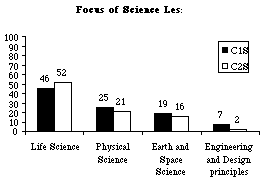
Figure 6
Focus of Cohort 2 Mathematics Lessons
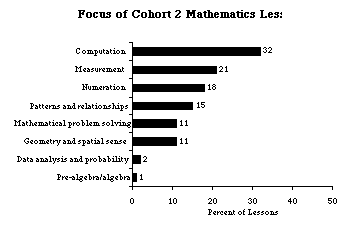
Figure 7
Most observed lessons included both a formal presentation by the teacher and some kind of
hands-on/investigative activity by the students, typically ones in which students followed a
detailed set of instructions rather than designing and implementing their own investigations.
Cohort 1 science classes taught by teachers who had already participated in LSC professional
development were more likely than others to be involved in writing reflections in a notebook or
journal and less likely to be working on answering textbook/worksheet questions. (See Table 4).
Table 4
Instructional Activities in Observed Classes
|
Percent of Classes |
|
Cohort 1 Science |
Cohort 2 Science |
Cohort 2 Mathematics |
| Formal presentation by teacher |
71 |
73 |
56 |
| Hands-on/investigative activity |
44 |
19 |
7 |
| Following detailed instructions |
2 |
1 |
45 |
| Record/analyze/represent data |
38 |
12 |
3 |
| Work on models/simulations |
65 |
22 |
17 |
| Design/implement own investigations |
12 |
11 |
1 |
| Play game to develop/renew knowledge/skills |
1 |
78 |
60 |
| Field work/field trip |
44 |
33 |
14 |
| Class discussion |
2 |
11 |
3 |
| Whole class, teacher led | 40 | 37 | 10 |
| Small groups | 1 | 59 |
8 |
| Whole class, student led | 15 | 24 | 17 |
| Reading/writing/reflection | 3 |
2 | 89 |
| Writing reflections in notebooks/journals | 72 | 57 | 18 |
| Reflecting on activities individually or in groups | 6 |
3 | 14 |
| Answering textbook/worksheet problems | 0 | 18 |
15 |
| Reading about science/mathematics | 3 |
0 | 45 |
| Practicing routine computations | 1 |
5 | 38 |
| Identifying patterns | 7 | 12 |
5 |
When asked how the LSC professional development had affected their classroom teaching,
teachers pointed to less reliance on textbooks and more use of student-centered strategies,
including cooperative learning groups. Observations confirmed the teacher reports; lessons
taught by teachers who had participated in LSC professional development were more likely to
receive high ratings from evaluators on lesson design and implementation, as well as on the
quality of the content and the classroom culture. (See Figure 8.)
Lessons Receiving High Ratings on Each Component
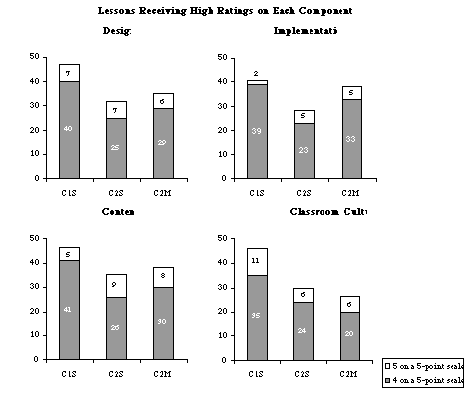
Figure 8
Lessons taught by teachers who had participated in LSC professional development were rated
particularly high on the extent to which:
- The discipline was portrayed as a process of inquiry, and the lesson incorporated tasks, roles, and interactions consistent with inquiry;
- Concepts and processes were balanced appropriately;
- The room arrangement encouraged student-centered interaction;
- Students were encouraged to generate ideas, conjectures, and propositions; and
- The degree of closure or resolution of conceptual understanding was appropriate for the purposes of the lesson.
As the final step in completing the observation protocol, evaluators were asked to indicate the
"level" that best described each lesson they observed. Table 5 shows the percent of lessons in
each Cohort considered effective instruction, beginning stages of effective instruction, and
ineffective instruction.3 Note that only 32 percent of Cohort 1 science lessons were rated as
effective instruction, quite close to the 27 percent of Cohort 2 science lessons and 29 percent of
Cohort 2 mathematics lessons that were rated that highly. The major difference between Cohort 1
and Cohort 2 science lessons is at the lower end of the scale, with lessons of treated teachers
more likely to be considered in the beginning stages of effective instruction and less likely to be
considered ineffective instruction.
Table 5
Overall Ratings of Observed Classes
|
Percent of Lessons |
|
Cohort 1 Science |
Cohort 2 Science |
Cohort 2 Mathematics |
| Effective Instruction | 32 | 45 | 29 |
| Beginning stages of effective instruction | 27 | 36 | 37 |
| Ineffective Instruction | 29 | 54 | 17 |
The shaded boxes contain examples of lessons that were assigned to each of these categories.
Lesson #1:
Ineffective Science Instruction-Passive "Learning"
The teacher stands at the front of a sparsely-equipped urban classroom and leads his third grade
class, composed of mostly minority students, through a lesson about the life cycle of a butterfly.
Using commercially-prepared packets, the teacher proceeds page-by-page, asking students to
locate and hold up the correct page and assigning, round-robin fashion, the task of reading aloud.
After reading, the teacher asks questions that require one-word answers, which he writes on the
board, and students copy into their notebooks. The students then fill out worksheets. The
information presented is limited to the names of the life stages; there is no reference to the
processes of change and the lesson seems more like a reading/vocabulary lesson than science.
Although desks are arranged in groups, there is no collaboration among students. The lesson
appears too simple for the children, although they are eager to participate, to give the "correct"
answers, and to fill in the blanks on their worksheets. |
Lesson #2:
Ineffective Mathematics Instruction-Activity for Activity's Sake
As students in this seventh grade mathematics class arrive and take their seats, they open their
notebooks and begin correcting their homework based on answers projected on the overhead
screen. The teacher then turns off the overhead, and reviews previous work the class has done
with measurement, especially alternative methods of measurement (such as arm span, finger
length, stride length). She then instructs the class to open their math text to the page containing
today's activity: measuring places on campus using alternative methods of measurement.
Students are told to form groups of 2-4 and go outside to take measurements. There is little time
for students to ask questions; some are clearly bewildered by the assignment, but the teacher is
unaware of their reaction. Later, as students return from outside, they seem more focused on
socializing than on math. The only closure at the end of the class is to tell students to present
their measurements the next day. |
Lesson #3:
Beginning Stages of Effective Mathematics Instruction
A kindergarten class engages in several activities to reinforce counting, adding, and subtracting
skills. The teacher introduces the lesson by holding up Unifix cubes (two red, one white) and
asking students the total number of cubes. When students offer answers, she asks them how they
got their answers and reinforces their responses by reminding them there are different ways to
arrive at answers. The lesson continues with a game using Unifix cubes and laminated game
boards. The whole class sits in a circle, and students take turns rolling a die and adding or
subtracting cubes on the game board with the teacher's help ("Lisa rolled a 5--how many would
it take to get to 5 on your board if you already have 2 cubes on it?"). Students later pair off to
play another game with the cubes. Students are engaged, and it is evident that the majority see
the various ways to determine the total number of cubes (counting, adding, subtracting).
However, little debriefing or discussion takes place after the activities. |
Lesson #4:
Effective Science Instruction
As part of a plant unit that includes several related activities, including a visit to a neighborhood
nursery, fourth grade students meet to discuss the progress of their extended experiments.
Working in groups of four, they have previously planted six seed pots: three as a control group,
and three with one variable changed (e.g., extra fertilizer, blue dye in water, watered with soda).
The groups share the results of their experiments so far, demonstrating facility in working
collaboratively, in reporting back to the class, and in using appropriately vocabulary words such
as "control" and "variable." The teacher is confident and well-versed in science, but allows the
students to lead discussions; all students, particularly girls, are noticeably at ease in their
presentations, even when expressing some uncertainty or tentativeness about their ideas. To close
the lesson, the teacher outlines the parameters for another experiment. Each group of students
works together to choose their own variables to test, and they write a plan based on their
discussion. |
Lesson #5:
Effective Mathematics Instruction
To practice subtraction skills, a first grade teacher reintroduces a previously-played game
involving a set number of Unifix cubes in a bowl or tub. Reviewing earlier lessons, the teacher
asks for examples and students demonstrate various subtraction strategies including counting
cubes, counting with fingers and elbows, and drawing pictures. Then students pair off to play
several rounds of "The Tub Game": taking turns, one student hides some of the 12 Unifix
cubes, and the partner determines the number of hidden cubes based on the number remaining
in the tub. The student then writes a "number sentence" (equation), and checks with the partner
to confirm that the equation matches the actual number of cubes taken from the tub. Students
are engaged and collaborative, if somewhat competitive, and appear to be making the connection
between the symbolic and the concrete. The lesson ends with a group discussion of difficulties,
helpful strategies, and a few additional student demonstrations. The teacher's focus is
on each student using the strategies that help her/him the most. |
A complementary analysis based on questionnaire data looked at classroom practice of teachers
who reported varying levels of involvement in science and mathematics professional development.
Teachers who had participated in a substantial amount of professional development in the
previous year were most likely to feel well prepared to teach science and mathematics, and to use
the instructional strategies advocated by national standards. For example, as can be seen in Figure
9, only 37 percent of classes whose teachers had not participated in science professional
development engaged in hands-on activities at least once a week, compared to 70 percent whose
teachers had had in-depth professional development.
Frequency of Hands-On Activities
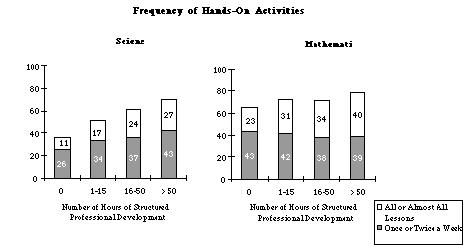
Figure 9
|
Similarly, teachers in Cohort 1
projects showed an increase
between 1995-96 in their feelings
of preparedness to manage a class
of students using hands-on
activities and in the frequency with
which they used these activities in
their classes. (See Figure 10.)
|
Cohort 1 Science Teachers Use of Hands-On Activities
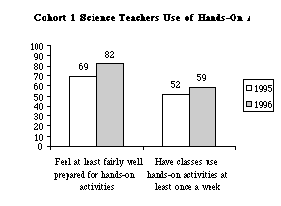
Figure 10
|
Supportive Context for Reform
The major emphasis of the LSC is on professional development to enable teachers to effectively
implement high quality instructional materials. At the same time, NSF recognized the need for
projects to look at the entire system in these districts, not only professional development and
instructional materials, but also policies related to student assessment; teacher recruitment,
orientation, and evaluation; and systems for purchasing/managing materials and supplies. Clearly,
the support of key stakeholders for the reform effort is crucial, not only from district and school-level
administrators, but also from parents and the larger community. Finally, NSF hypothesized
that reforms would be greatly enhanced if they had the support of business and industry; colleges
and universities; and other "science-rich" institutions.
The core evaluation includes information about the supportiveness of the context for reform from
a number of sources. In questionnaires and interviews, teachers were asked about the support
they receive from parents, principals, and other teachers in their schools. Principals were also
asked about their opinions in relation to science and mathematics reform, including how important
they considered various reform approaches, and how well prepared they felt to support teachers in
the implementation of national standards. In addition, teacher and principal questionnaires asked
about the extent to which school and district policies affect science and mathematics instruction.
Finally, evaluators were asked to describe the extent to which district policies and resources were
aligned in support of the LSC reforms.
Teachers in the LSC districts generally feel supported by other teachers in their schools to try out
innovative ideas in science and mathematics teaching, with roughly 3 out of 4 teachers agreeing
with statements to that effect. Somewhat fewer, about 2 out of 3, indicated that teachers in their
school regularly share ideas and materials. Only about 1 out of 8 teachers indicated they had time
during the regular school week to work with their peers on science and mathematics curriculum
and instruction.
In both science and mathematics, teachers are most likely to report that principals encourage
innovative instructional practices and accept the noise that comes with an active, inquiry-based
classroom (roughly 4 out of 5 in each group). Mathematics teachers were more likely than
science teachers to report that their principals provided them with the necessary instructional
materials and equipment; and encourages them to gear curriculum and instruction to address
individual students' learning.
Principals and teachers were also given a list of "factors" that might affect instruction and asked
to indicate the extent, if any, of the problem each caused for science and mathematics instruction.
Teachers were answering about problems in their own instruction, and principals were answering
about the school as a whole. From both the teacher and principal perspective, there is
considerable room for improvement in the extent to which the policy environment supports
science and mathematics instruction. In both science and mathematics, lack of time to work with
other teachers was the most frequently cited problem, with more than half of the Cohort 1 and
Cohort 2 science teachers and nearly that many Cohort 2 mathematics teachers labeling it a major
problem.
Access to computers ranked second, again with more than half of the teachers in science and
nearly half in mathematics indicating that a lack of computers was a major problem. Other
frequently cited problems, especially for science instruction, included lack of funds for purchasing
equipment and supplies, and lack of time to plan and prepare lessons. Principals generally echoed
the concerns expressed by teachers, frequently citing such problems as inadequate funds for
purchasing equipment and supplies, and the lack of teacher planning time and opportunities to
work together.
Evaluators were also asked to rate the extent to which district policies and practices tended to
facilitate reform or act as barriers for reform. Based on their reports, the most frequent
facilitators of reform in LSC districts are the professional development systems; the curriculum,
scope and sequence; the fact that the various reform efforts are consistent with one another; and
the quality of instructional materials.
Cohort 1 districts received higher marks than Cohort 2 districts in a number of areas, including
the quality of instructional materials and new teacher orientation. In contrast, Cohort 2 districts
tended to be more highly rated in terms of consistency among reforms. In both cohorts, teacher
evaluation policies and within-school policies such as time for teachers to plan and prepare lessons
were rarely seen as facilitators of reforms.
A number of evaluators spoke of the commitment the districts had made to aligning their policies
in support of the LSC reforms. The following are topical comments:
"Districts have given [LSC project] leaders and connected curriculum review
groups the responsibility of revising the district science standards and aligning
them with the emerging state [frameworks] in science."
"The district's recent decision to adopt new standards-based science and
mathematics materials demonstrates a willingness to work in conjunction with, if
not in direct support of, the goals of the LSC."
"The district has purchased kits which are already in use in some schools, and the
district has made a major commitment to purchase more. Efforts are underway to
create a system for purchasing and managing materials and supplies."
In other cases, evaluators noted that there had been major improvements in the availability of
materials for hands-on instruction, but the improvements appeared project-based rather than
rooted in district commitments.
"Prior to joining [the project], teachers bought their own science materials or, in
some cases, districts provided materials. Currently, [the project] assembles,
delivers, picks up, and refurbishes materials, greatly reducing the burden on
teachers and districts."
Finally, some evaluators in other projects reported that financial difficulties pose serious problems
for reform in the districts.
"[Our site] is implementing its LSC within the context of depressing and
undermining budget cuts and staff readjustments. The position of teacher expert
has disappeared form the system, vice principals have been cut, and much
professional development has been eliminated."
"A lack of materials has been prohibitive...since these schools started with no
materials, they will need to make future investments for several years."
"Currently, many teachers are forced to supplement their stock of materials with
items purchased with their own money. They look forward to the time when all
classrooms will be equipped with adequate materials."
Evaluators were asked to summarize their findings by placing each project at the appropriate
point on a continuum of "supportiveness of context". As can be seen in Table 6, most projects in
each cohort were considered "transitioning toward a supportive context."
Table 6
Continuum Rating for Supportiveness of Context
|
|
Percent of Projects |
|
Cohort 1 | Cohort 2 |
| Level 1: Predominance of Non-Supportive Context | 0 | 0 |
| Level 2: Minimally Supportive Context | 25 | 0 |
| Level 3: Transitioning Toward Supportive Context | 63 | 72 |
| Level 4: Emerging Supportive Context | 13 | 28 |
| Level 5: Predominance of Supportive Context | 0 | 0 |
Sustainability of the LSC Reforms
One of the "systemic" aspects of the LSC initiative is the expectation that districts will be able to
sustain the reforms after the NSF funding period has ended. Evaluators were asked to rate the
extent to which the participating districts have the capacity to implement high-quality professional
development, the resources available to support it, and the structures in place to sustain high-quality
professional development systems. As several evaluators noted, these ratings are based on
a mixture of data and "impressions," but they do provide a broad indication of the status of the
districts' professional development systems.
Evaluators were asked to indicate the "continuum level" which best describes the status of the
professional development system within the targeted districts. As can be seen in Table 7, most
Cohort 1 science projects were judged to be "transitioning toward a high-quality professional
development system." Apparently, a number of the Cohort 2 districts had made progress towards
institutionalizing high quality professional development systems prior to receiving the LSC
awards, with a third of the projects rated as "emerging infrastructure" or even having already
institutionalized such a system in the baseline year of their LSC.
Table 7
Continuum Rating for Sustainability
|
Percent of Projects |
| Cohort 1 | Cohort 2 |
| Level 1: Predominance of Ineffective Professional Development System |
0 | 6 |
| Level 2: Exploring Components for High-Quality Professional Development System |
25 | 29 |
| Level 3: Transitioning Toward a High-Quality Professional Development System |
63 | 35 |
| Level 4: Emerging Infrastructure for High-Quality Professional Development System |
13 | 24 |
| Level 5: Institutionalization of a High-Quality Professional Development System |
0 | 6 |
While data from Cohort 1 projects are technically not "baseline," it is still early in the life of these
projects to be looking for signs of sustainability. For that reason, and also because the Cohort 2
projects appear to have been further along in institutionalizing high-quality professional
development at the time they began their LSC grants, evaluator ratings of individual aspects of
sustainability are presented together.
Evaluators report that in roughly two-thirds of the projects, districts have invested in enhancing
the expertise and capacity of lead teachers and that these teachers are actively engaged in
facilitating professional development activities (based on the percentages responding 4 or 5 on a
five-point scale from 1, "not at all" to 5, "to a great extent").
In addition to the capacity to provide high-quality professional development, districts will need
resources to support these programs. Figure 11 shows evaluators' ratings of a number of aspects
of resource availability. Note that while in more than half of the LSC projects the districts
actively seek opportunities to provide on-going, high-quality professional development
experiences for their teachers, the use of district funds for these purposes is less common.
Resources to Support On-Going Professional Development
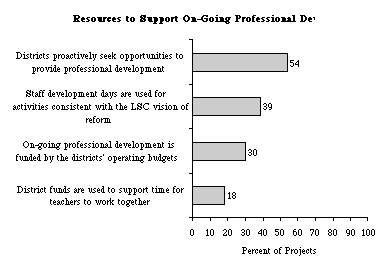
Figure 11
Finally, districts will need structures in place to sustain high-quality professional development and
provide a supportive context for exemplary instruction in science and mathematics. Evaluators in
less than half of the projects reported that the districts provide incentives for teachers to
participate in on-going professional development. And while 4 out of 10 have structures in place
for continuously assessing and improving their professional development systems, only 1 in 5 has
mechanisms in place for monitoring policy alignment, and only 1 in 4 for maintaining support for
reform among community stakeholders.
Horizon Research, Inc. 01/06/98 15
1 An abstract of each of these projects is included in the "Local Systemic Change Project Directory" available from the National Science Foundation
and can be accessed through the NSF home page at www.nsf.gov/cgi-bin/getpub?nsf 97145.
2 A more detailed treatment of the evaluation results can be found in the Local Systemic Change through Teacher Enhancement 1995-96 Cross-Site
Technical Report, available from Horizon Research, Inc.
3 "Ineffective instruction" includes lessons the observers categorized as level 1a, passive learning; level 1b, activity-for-activity's sake; and level 2,
elements of effective instruction. Lessons rated a low or solid 3 are considered "beginning stages of effective instruction," while those rated a high 3,
4, or 5 are considered "effective instruction."
|
 |

